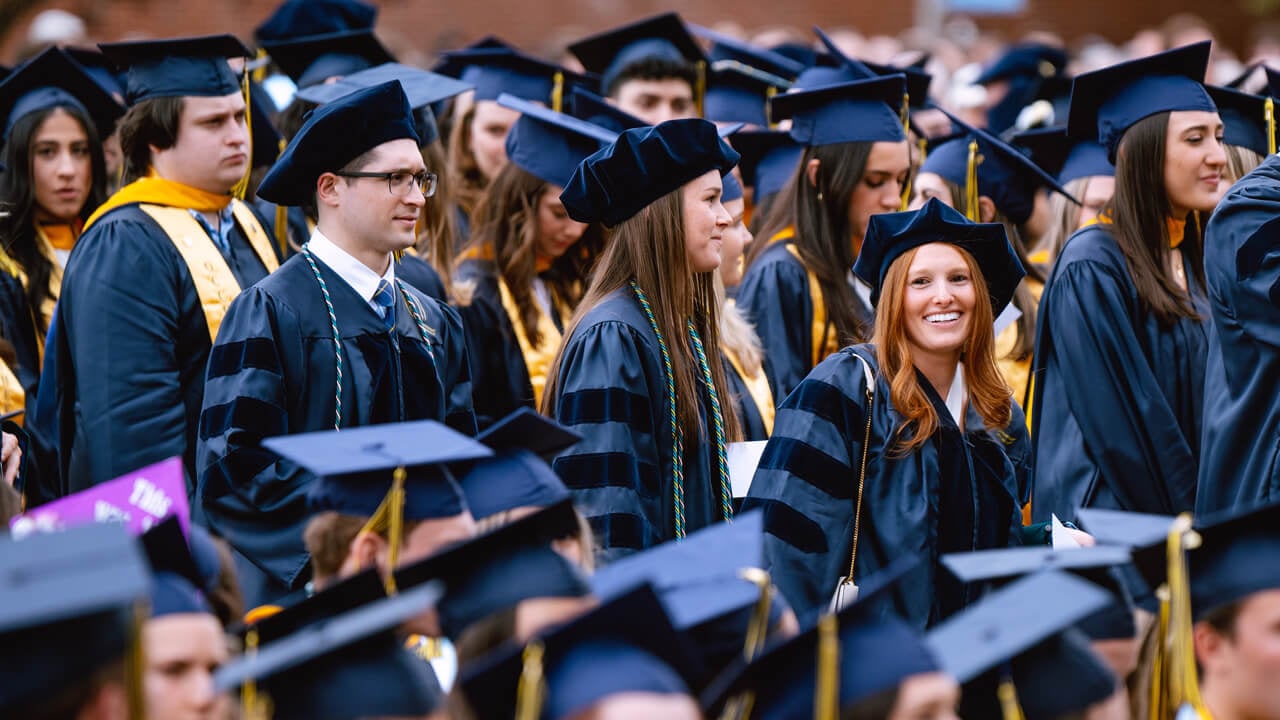
Healthcare executive tells graduates fortitude will be their armor in the face of adversity
May 11, 2024

May 11, 2024


“Today marks a monumental achievement in your lives,” Venoit said Saturday on the Mount Carmel Campus Quad. “You stand at the threshold of a career with immense promise and responsibility as you prepare to embark on this journey into the healthcare industry.”
Venoit has been a valued partner in creating unique learning opportunities for Quinnipiac students, including the transformative Quinnipiac-Masonicare student-in-residence partnership with the School of Health Sciences. During the academic year, two students live with their older adult neighbors at Masonicare while pursuing their Master of Occupational Therapy studies.
It’s novel experiences like these that prepare Quinnipiac students for the rigors and rewards of their future careers.
“Perseverance will be your steadfast companion on this journey. The road ahead will undoubtedly present challenges and obstacles that sometimes seem insurmountable,” Venoit said. “But it's in those moments of adversity that your perseverance will shine brightest. It's the resilience to push forward, even when the path is difficult. That will define your character and ultimately your success. Fortitude will be your armor in the face of adversity.”
President Judy Olian recalled how the Class of 2024 began its Quinnipiac education in the throes of a pandemic and still rose to the occasion.
“I congratulate you — and I thank you — for adapting and adjusting with grace and generosity to yes, a pandemic,” Olian said. “You weathered that period with strength and resilience. You supported each other. You emerged stronger, and here you are, finishing on a high note with a brilliant future ahead.”
The experiences from that first year bonded these students deeply and personally.
“When I look at this class,” Olian said, “I see the trailblazers of tomorrow who are prepared to embrace accelerated change, and to do more than that — you will lead change in occupational therapy, in physical therapy, in biomedical sciences, in social work, in microbiology, in diagnostic imaging, in athletic training and sports medicine, and more.”
Olian also recognized Tania Grgurich, clinical professor of diagnostic imaging, who was named healthcare educator of the year by the Hamden Chamber of Commerce in April. Grgurich was honored after donating a live kidney for one of her students, which led to two people getting new kidneys and her student being guaranteed a live kidney donation.
“She’s very special to us,” Olian said with a smile.
Grgurich, who sat on the stage with the platform party of university officials, carried the mace in the Commencement procession. The mace is a staff-like symbol of academic authority.
The ceremony’s student speakers brought their own stories of academic authority as newly minted graduates.
Kubi-Ayana Chinyere Alexandria Walters ’24, who earned her Bachelor of Science, represented the undergraduate students as their student speaker.
“Quinnipiac has equipped us with the knowledge and skills to excel in our respective fields whether it be biomedical sciences, microbiology and immunology, health sciences, athletic training, physical therapy, occupational therapy, social work or radiologic sciences,” Walters said.
“Despite the uncertainties of the COVID-19 era, we, the Class of 2024 have disproven the scientific notion that we would be disconnected from each other and have emerged as a resilient community and made lifelong connections,” Walters added.
“So whether we land in academia, industry, research, or graduate school, as we leave with our degrees, please know you have the skills to conquer any future endeavor. May our pathways be illuminated by the enduring connections and friendships we’ve forged,” she said.
Alec James Williams '22, MHS ’24, who earned his physician assistant degree, represented the graduate students as their student speaker. The little boy who used to wear green “Hulk Hands” around the house is all grown up now.
“Although I still love Superman’s invincibility and Hulk’s strength, the superheroes I admire today don’t wear capes or fly. Yet, they still possess incredible strength and courage,” Williams said. “Whether your heroes packed your grade school lunches, coached you through sports, or were in the classroom and sit front row here today.
“All of our heroes have stood by us through our toughest battles to help us arrive at this monumental achievement,” Williams added. “Today, we are being inducted into a community of health science professional Avengers wearing lab coats and stethoscopes, instead of capes or fluorescent tights.”
After Provost Debra Liebowitz began the proceedings with the call to Commencement, Sabine Hasan, OTD ’24, sang the national anthem before thousands of parents, family members and friends on the Mount Carmel Campus Quad.
At the conclusion of the ceremony, Pam Martinez ’86 welcomed the Class of 2024 into an alumni community of more than 70,000 members around the world, with a reminder that a Quinnipiac education is a relationship that lasts a lifetime.

Pomp and Circumstance, Sir Edward Elgar
Debra J. Liebowitz, PhD
Provost
Sabine Hasan, OTD ’24
Judy D. Olian, PhD
President
Undergraduate: Kubi-Ayana Chinyere Alexandria Walters
Graduate: Alec James Williams
Tania Grgurich, DHSc
Clinical Professor of Diagnostic Imaging
Jon-Paul Venoit
President and Chief Executive Officer, Masonicare
Janelle Chiasera, PhD
Dean
Judy D. Olian
Pam Martinez ’86
Alumni Association Board

President & CEO at Masonicare
School of Health Sciences Ceremony | Saturday, May 11, 3 p.m.
Jon-Paul (JP) Venoit, president and CEO of Masonicare, began his career at 16 working in dining services at Masonicare. Thirty years later, he stands at the head of the largest not-for-profit senior care company in Connecticut. Venoit has been recognized as a distinguished leader for guiding the organization through a global pandemic to achieve one of the most successful years of operation in Masonicare history. Venoit is also a valued partner of Quinnipiac University. He continues to be instrumental in creating unique learning opportunities for students, including the establishment of the transformative Quinnipiac-Masonicare students-in-residence partnership with the School of Health Sciences. Active within the community, he also serves as vice chair of the Wallingford Planning and Zoning Commission and commissioner of the Wallingford Ethics Committee. He is a former chair of the Wallingford Education Foundation and former chair of the Connecticut Assisted Living Association Board and its Institute for Senior Living Education.

Congratulations to the Class of 2024! You are well prepared to continue your life journey as professionals who will impact the world and the workplaces of tomorrow. We are confident you will apply your talent, passion and education to serve boldly as engaged citizens in your communities — and beyond. These qualities are at your core and will continue to propel you well into the future.
As graduates of Quinnipiac University, you have learned from a distinguished faculty and a committed staff who proudly stand beside you today. You also have learned valuable lessons from each other during this most transformative time in your lives. Please stay connected to our Bobcat family, visit us often, and draw upon the many friendships and mentorships you have formed here.
This day is shared with your families and friends, those who also deserve special recognition and appreciation for their contributions to your success. Enjoy this momentous achievement! Together, we are cheering for you, with utmost pride.
Warmly
Judy D. Olian
The mace — a symbol of authority — has antecedents in both Roman and Medieval history. The Roman mace (fasces) was carried by a lictor before the chief magistrate of the city, as well as before the legions. During the Middle Ages, the mace (mateola), a weapon of war, became first a symbol of victory and then a symbol of authority. The mace emblazoned with the Great Seal of England became a symbol of authority in Parliament by the end of the 13th century. It is this form of the mace that was the prototype of those symbols of authority, not only of legislative bodies, but also of cities and universities.
In 1246, following some 20 years of strife, the University of Paris was finally conceded the right to its own common seal. Since then, the use of the seal engraved on the mace has come to symbolize the authority of the academic community. In July 2000, Quinnipiac commissioned the noted sculptor Robert Meyer of Westport, Connecticut, to design and execute a new mace for Quinnipiac University. Cast in bronze, the mace incorporates elements of the university seal.
The medallion (medal of office), like the mace and the seal, is also a symbol of authority. It is possible that its roots may be traced back to the Roman “bulla” (a gold amulet of honor). The obverse of the medallion shows the seal of the office the wearer holds — in our case, the seal of the university. Not infrequently, the reverse would show the personal seal or coat of arms of the bearer. Since the High Middle Ages, the medallion has been worn by such officials as the chancellors of England, mayors of cities, and rectors of universities, and came to signify the high personal position such figures occupied in their respective governments. During the Renaissance, medallion design reached unique artistic heights, and in certain portraits the medallion was given particular prominence. The medallion is worn by the university’s president. The Quinnipiac medal showcases the university seal, sculpted in relief and cast in bronze.
The 12th and 13th centuries saw the formation of universities under the jurisdiction of the Church. Most students of the day were clerks in the Holy Order, monks or priests. Cowls or hoods adorned their habits and protected the young scholars from harsh weather and the pervading dampness of the stone buildings in which they studied. Hoods also served to cover tonsured heads before the use of the skullcap.
Today, the cap, gown and hood have taken on a symbolic meaning. Color and shape conform to an academic code signifying a university’s conferral of the degree and the nature of the degree conferred. Gowns for the doctoral degree carry velvet panels and three horizontal velvet bars on the upper arm of the full, round, bell-shaped sleeves.
Quinnipiac Today is your source for what's happening throughout #BobcatNation. Sign up for our weekly email newsletter to be among the first to know about news, events and members of our Bobcat family who are making a positive difference in our world.
Sign Up Now